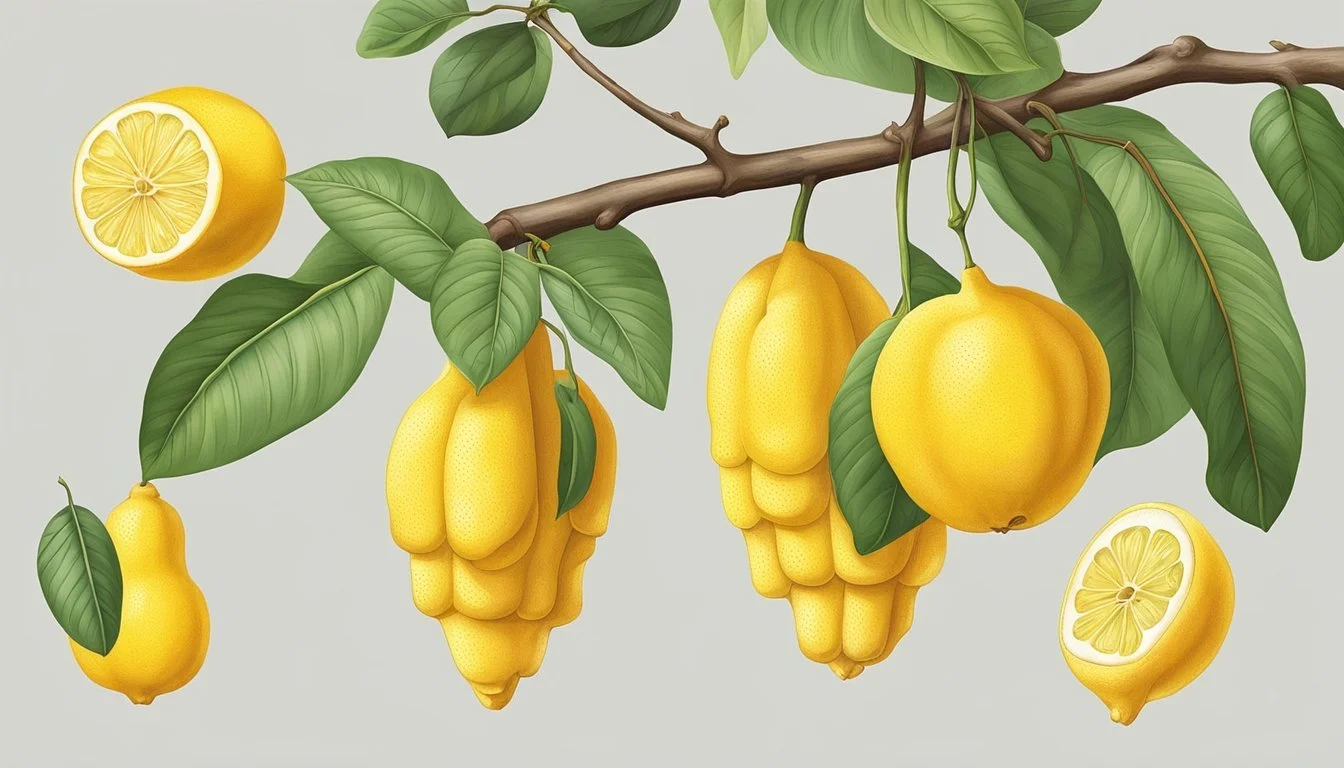How to Tell if Buddha's Hand Citrons Are Ripe
Your Essential Ripeness Guide
Determining the perfect moment to harvest Buddha's Hand citrons is essential, not only for enjoying their unique culinary qualities but also for utilizing them in various non-edible applications. This exotic fruit, cherished for its striking appearance and fragrant zest, can be quite the conversation starter. Unlike traditional citruses, Buddha’s Hand lacks juicy segments, but its rind offers zest that can be used in numerous recipes and infusions. Knowing how to tell whether the fruit is ripe ensures that all the intricate flavors and aromas are at their peak.
The ripeness of Buddha's Hand can be identified through a few key indicators. As the fruit matures, a shift in color from bright green to a mellow yellow signifies that it's approaching ripeness. It is equally important to be aware of the textural changes on the rind and the strong, lemony fragrance that intensifies as it ripens. When it comes to harvesting and storing, gentle handling and appropriate temperature regulation will maintain the quality of the fruit, ensuring its inimitable contribution to meals, drinks, and aromatic decor endures.
Key Takeaways
Identifying ripe Buddha's Hand involves color, texture, and fragrance observations.
Proper harvest and storage techniques preserve the fruit's quality.
Ripe Buddha's Hand enhances both culinary and non-culinary applications.
Understanding Buddha's Hand Citron
The Buddha's Hand citron, identifiable by its unique finger-like segments, is an intriguing citrus with deep cultural roots. This section will explore its origins, distinctive features, cultural importance, and the aspects of its cultivation.
Origin and History
Citrus medica var. sarcodactylis, commonly known as the Buddha's Hand citron, traces its origins to the lower Himalayas, potentially originating from northeastern India or China. This fruit has a significant place in traditional medicine and has been used across Asia for centuries. Esteemed in countries like China, the Buddha's Hand is often associated with happiness, luck, and good fortune.
Physical Characteristics of the Citron
The Buddha's Hand is a variety of citron that stands out for its unusual shape, resembling multiple yellow finger-like segments that can be likened to human fingers. Unlike other citrus fruits, it typically lacks flesh and pulp inside. Instead, the fruit is mostly made up of rind and a white pith, which are both aromatic.
Cultural Significance
Symbolically, the Buddha's Hand is associated with long life and good luck, making it a popular gift at events such as the Lunar New Year. It is not uncommon to find this citron offered in Buddhist temples, often as a token to bestow blessings of happiness and prosperity.
Varieties and Cultivation
While there are a few different varieties of the Buddha's Hand, the growth requirements remain consistent. As part of the citron family, this rare citrus fruit flourishes in well-drained soil and full sun conditions. Gardeners typically grow Buddha's Hand grafted onto rootstock which aids in the plant's resilience and fruit production.
Growing Buddha's Hand Citron
Cultivating Buddha's Hand Citron successfully hinges on providing the tree with ideal conditions and attentive care. The grower should be mindful of lighting, soil composition, and regular maintenance to ensure health and fruit production.
Ideal Growing Conditions
Buddha's Hand Citron thrives in full sun and requires at least 5-6 hours of direct sunlight daily. It prefers well-draining soil, which can be achieved by mixing in sand or perlite if necessary. The plant is sensitive to cold and should be grown in USDA hardiness zones 10-11 or in a greenhouse in cooler regions.
Sunlight: Minimum 5-6 hours of direct sunlight
Soil: Well-draining, sandy mix
Hardiness Zones: 10-11 or greenhouse for cooler areas
Planting and Care
When planting, ensure the hole is twice as wide as the root ball and mix in some compost to enrich the soil. Watering should be consistent, keeping the soil moist but not waterlogged. Fertilization can be done using a balanced citrus fertilizer according to the product's instructions. If space is limited, containers are an excellent alternative, provided they have adequate drainage.
Watering: Keep soil moist, avoid waterlogging
Fertilization: Use balanced citrus fertilizer
Containers: Ensure good drainage
Common Pests and Diseases
Citrus plants can be affected by pests like spider mites and scale insects. Regular inspection and prompt treatment are crucial. Common diseases include root rot, which is preventable by avoiding overwatering and using well-draining soil. Pruning any dead or diseased branches helps maintain plant health and prevent the spread of issues.
Pests: Spider mites, scale insects
Diseases: Root rot
Pruning: Remove dead or diseased branches promptly
Regular care, vigilance against pests and diseases, and provision of ideal growing conditions are essential steps in nurturing Buddha's Hand Citron.
Identifying Ripeness
Buddha's Hand citrons, known for their unique finger-like sections, reach ripeness not through traditional juicy fruit indicators but by distinct changes in color, texture, and aroma. Adequate ripeness ensures a fragrant zest optimum for culinary uses.
Color and Texture Indicators
When ripe, Buddha's Hand citrons exhibit a bright yellow hue. The skin's texture transitions to a slightly softer, yielding feel. Observing these changes is crucial:
Ripeness: Ripe Buddha's Hand has a uniformly bright yellow coloration, absent of any green tinges.
Texture: The peel should feel slightly firm but give gently under pressure, indicating that the texture has softened appropriately.
Aroma and Feel
The fragrance and tactile feel are telling signs of citrus fruit maturity:
Aroma: A ripe Buddha's Hand emits a strong, lemony and floral aroma that is pleasant and fragrant. The scent should be noticeable without having to scratch the surface.
Feel: When held, a ripe citron should feel heavy for its size, with sections resembling a closed hand or praying hand. The peel and zest provide useful sensory clues—a ripe fruit should be firm enough to hold its shape but not hard.
Harvesting and Storing
When harvesting Buddha's Hand citrons, one must watch for signs of ripeness for optimal flavor and storage. Proper storage methods can significantly extend the longevity of the fruit, maintaining its unique qualities.
Best Practices for Harvesting
When the Buddha's Hand citron reaches full size and its rind turns a bright yellow, it signifies ripeness. The skin should also emit a strong, pleasant aroma. It's crucial to handle the fruit gently and use clean, sharp shears to cut the fruit from the tree, leaving a small portion of the stem attached. This practice helps prevent damage to both the tree and the fruit.
Storage Tips for Longevity
After harvesting, the Buddha's Hand citron can be stored at room temperature for about one to two weeks. For extended storage, placing the fruit in the refrigerator can be beneficial. Wrap the fruit lightly in a plastic bag or use a produce drawer to maintain proper humidity levels. Under refrigeration, the citron can last up to four weeks. To prevent dehydration and the loss of aromatic quality, one should check on the fruit periodically during storage.
Culinary Uses of Buddha's Hand
Buddha's Hand, known scientifically as Citrus medica var. sarcodactylis, offers a bouquet of culinary possibilities to chefs and home cooks alike due to its fragrant zest and unique appearance. Especially valued for its zest and essential oils, this fingered citron lacks pulp and juice but is highly prized for its strong lemon fragrance.
Cooking Preparations
One can be adventurous with Buddha’s Hand zest by incorporating it into various culinary dishes. Traditionally, its zest is used to enhance flavor in:
Marmalade: Mixing thin strips of zest with sugar and water creates a distinctive marmalade with a complex citrus note.
Baked Goods: Infusing zest into doughs and batters for cookies, cakes, and bread offers a subtle yet distinctive lemony aroma.
Buddha's Hand is also candied, converting the rind into a sweet confection that can complement both savory and sweet dishes. When employed in culinary use, the candied peel serves as an enchanting garnish for desserts or as a delightful mix-in for granola or yogurt.
Unique Recipes and Pairings
Creative chefs discover that Buddha’s Hand contributes a twist to conventional recipes:
Teas: Steeping sliced Buddha’s Hand in hot water yields a tea with a refreshing lemon flavor.
Salad Dressings and Marinades: Grated zest can be whisked into vinaigrettes or marinades, instilling exotic citrus undertones.
Pasta: Finely chopped zest is an exquisite addition to pasta, offering an unexpected burst of lemon essence.
This fingered citron also lends itself to unique pairings. One might find thin slices of Buddha's Hand atop steamed fish or desserts, where its intense aroma complements subtle flavors. Whether used in sweet or savory contexts, Buddha's Hand leaves a memorable impression on the palate, celebrating the versatility of citrus in culinary applications.
Non-Culinary Applications
The Buddha's Hand citron, beyond its flavor, offers distinct uses in aromatic and decorative contexts, as well as in the realm of health and wellness due to its composition and traditional significance.
Aromatic and Decorative Purposes
Buddha's Hand is notable for its striking appearance, often used as an ornamental feature in homes and gardens. The segmented fingers resembling a human hand make it an alluring decorative element. Moreover, its fragrance is powerful; the zest releases a pleasant aroma, making it commonly used for natural fragrance purposes. It serves as a fresh, organic alternative to artificial air fresheners, and its scent is said to bring good luck into the home according to some cultural beliefs.
Buddha's Hand in Health and Wellness
Buddha's Hand is not just visually and aromatically appealing but also has its place in health and wellness. Traditionally used in Chinese medicine, the citron is believed to regulate energy (Qi) and enhance digestion. It’s enriched with vitamin C and fiber, bolstering its profile as a health-supportive ingredient. Although primarily used in a culinary context for these nutrients, Buddha's Hand can also be found in various traditional medicine preparations aimed at improving vitality and overall well-being.
Bartending with Buddha's Hand
The unique lemony aroma of Buddha's Hand citron makes it a perfect ingredient for elevating bar spirits and crafting signature cocktails. Its zest imparts a robust citrus flavor that can transform simple spirits and mixed drinks into extraordinary libations.
Infusing Spirits with Citron
To infuse vodka or other spirits with Buddha's Hand, bartenders typically follow a simple process. They begin by thoroughly washing the fruit to ensure it's clean. Using a zester, grater, or sharp knife, they then remove the outer rind, making sure to avoid the bitter white pith. The zest is added to the alcohol, often vodka due to its neutral flavor, and allowed to steep. The duration of this process can vary, but it generally ranges from a few days to several weeks, depending on the desired intensity of flavor.
Infusion Steps:
Wash the Buddha's Hand citron thoroughly.
Zest the peel, avoiding the pith.
Immerse the zest in vodka or desired spirit.
Steep for a desired period, tasting periodically.
Strain out the zest before bottling.
After straining, the infused spirit can be used as a base for various cocktails or consumed on its own. It can also serve as a homemade alternative to limoncello, offering a more complex, deeply citrusy flavor profile.
Crafting Buddha's Hand Cocktails
When it comes to cocktails, the aromatic essence of Buddha's Hand pairs well with ingredients that complement its citrus notes. For example, a simple syrup can be crafted by combining sugar with the fruit's zest and letting it macerate, infusing the syrup with its distinctive aroma. This syrup serves as a versatile sweetener for a variety of cocktails.
Key Cocktail Components:
Buddha's Hand simple syrup: A sweetener with a rich citrus flavor.
Fresh juices: Lemon, lime, or grapefruit juice to enhance the citrusy notes.
For a refreshing Buddha's Hand cocktail, mixologists may combine the infused vodka with the homemade citron syrup, fresh juice, and a splash of soda water. They might also incorporate the syrup into tea-based cocktails for a subtler, yet fragrant twist. Garnishes often include a thin strip of the fruit's zest or a twist to accentuate the drink's citrusy perfume.
Example Cocktail Recipe:
1 1/2 oz Buddha's Hand infused vodka
1 oz Buddha's Hand simple syrup
3/4 oz Fresh lemon juice
Splash of soda water
Garnish: Twist of Buddha's Hand zest
To serve, bartenders shake the infused vodka, syrup, and fresh juice with ice. They strain it into a chilled glass, add a splash of soda, and garnish with the zest. Each element of the cocktail showcases the citron's complex flavor and ensures a memorable drinking experience.
Glossary of Terms
In this section, the reader will become familiar with specific terminology related to citrons, particularly the Buddha’s Hand variety. Understanding these terms is vital for recognizing the ripeness and characteristics of this unique citrus fruit.
Definition of Citron-Related Terms
Citron: A large, fragrant citrus fruit with a thick rind, botanically known as Citrus medica. It is one of the original citrus fruits from which other citrus types have developed.
Buddha's Hand: A distinctive variety of citron characterized by its unusual shape, resembling fingers extending from a palm. It typically contains no or very little pulp and juice.
Shape: Refers to the physical form of the Buddha's Hand, which can vary from containing five to over twenty finger-like sections.
Bitter: Describes the flavor profile often associated with the rind of certain citrus fruits, including some varieties of citrons.
Sweet: Some citrons, including Buddha's Hand, can have a sweet flavor, particularly noted when the rind is candied.
Rind: The outer skin of the citrus fruit which can be thick and fragrant in citrons. It can be used fresh, candied, or zested.
Pulp: The juicy, fleshy part inside a citrus fruit. Buddha's Hand typically lacks substantial pulp.
Juice: The liquid that comes from the pulp of citrus fruits. Buddha's Hand citrons usually do not generate juice due to the absence of substantial pulp.
Candied: A process of cooking the rind or peel in sugar syrup, often used to preserve and sweeten the rind of citrons for consumption.
Zest: The outermost part of the rind of citrus fruits, grated or peeled as thin strips, used to add flavor to food and beverages.
Grated: Describes the act of shredding the zest into fine pieces, often used to infuse flavor in various recipes.
Peel: The collective term for the zest and the white pith of citrus; in citrons, it's often used as a whole in candied preparations.
White Pith: The bitter, white layer found between the rind and the pulp. In citrons, the pith can be quite thick.
Firm: The texture of a ripe Buddha’s Hand, as the fruit should feel solid and not give too much when squeezed gently.
Seeds: Citrons can have seeds, although Buddha's Hand often has few to none due to its reduced pulp region.








